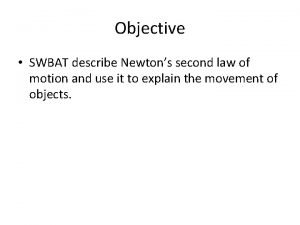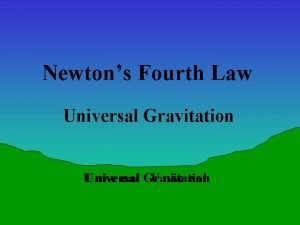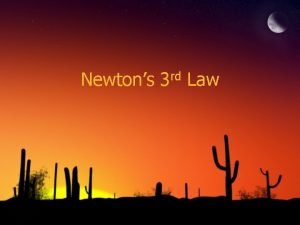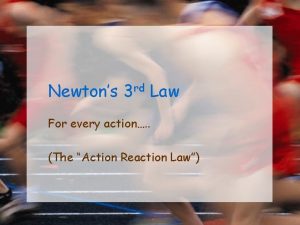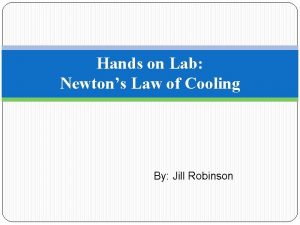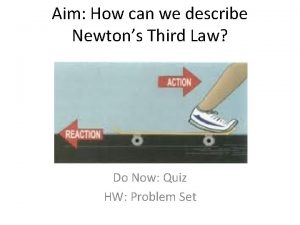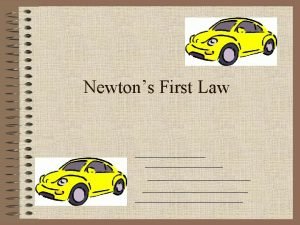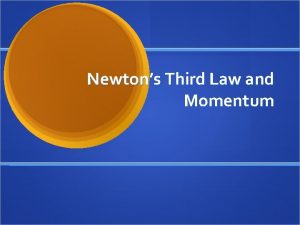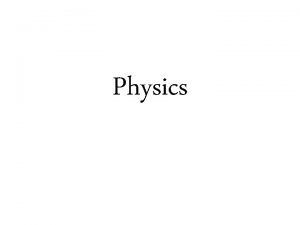Newtons 1 st Law Newtons 1 st Law













- Slides: 13

Newton’s 1 st Law

Newton’s 1 st Law Every object stays at rest or moves in a straight line at a constant speed unless a net force changes its motion.

Q. Why will the coin drop into the glass when a force accelerates the card? A. The coin is at rest and remains at rest when the card is hit out from underneath it. There is not enough force to make it move with the card.

Q. Why does the downward motion and sudden stop of the hammer tighten the hammerhead? A. The hammerhead is moving downward at a constant speed. When the hammer stops suddenly, the hammerhead continues its motion downward until it is forced to stop.


Q. Why is it that a slow continuous increase in the downward force breaks the string above the massive ball, but a sudden increase breaks the lower string? A. When the force is applied slowly, the force on the upper string is greater than the force on the lower string (Fupper=Fpull+Fball’s gravity), so the string breaks above the ball. When the force is applied quickly, the ball continues to stay at rest because it is initially at rest. There is no additional force on upper string, so the lower string breaks.

Q. You roll a golf ball flat on the ground. On the ground is a curved wall. The ball follows the path in the figure. When it gets to the end of the wall, which way will it go: path 1, path 2, or path 3? Use Newton’s 1 st Law to explain why. A. The golf ball will follow path 2, because it must move in a straight line at constant speed since there are no other forces acting on it. The is Newton’s 1 st law.

Q. A car is driving along a flat, straight road at 50 km/hr. What net force is necessary to keep this motion the same? A. None! Any net force will cause the motion of the car to change. B. There must be no net force if the car is to continue with the same motion.

Q. A car is driving along a flat, straight road at 50 km/hr. The tires are pushing the car forward (force A), and the wind and road are pushing back on the car (force B). If motion of the car does not change, which of the following is true? a. Force A is bigger than force B. b. Force A is equal to force B. c. Force A is smaller than force B. A. A=B, because there must be no net force for motion to remain unchanged.

Q. Imagine that you are floating in space. You have two identical boxes. One is empty, and one is filled with sand. How can you tell which one has the sand if you can not open either of the boxes? A. Shake the boxes. The box with the greater mass offers greater resistance to a change in its motion.

Q. Why is an axe with more mass better at chopping wood that an axe with less mass? A. When the more massive axe hits the wood, it is more resistive to changing its motion than the less massive axe would be. B. As a result, it will go deeper into the wood and chop the wood more effectively.

Q. When you use one hand to pull a piece of toilet from a roll, why is it better to pull quickly than to pull slowly? A. The inertia of the toilet paper roll resists a rapid change in motion more than it resists a slow change in motion. Pulling slowly will unwind the roll. Pulling quickly will rip off a piece of toilet paper.

Q. Can the motion of an object change if there is no net force acting on it? A. No! Newton’s 1 st Law states that a force is necessary to change the motion of an object.
 Newtons 3 rd law of motion
Newtons 3 rd law of motion Inertia in soccer
Inertia in soccer Describe newtons second law
Describe newtons second law What object has more inertia
What object has more inertia Newton's fourth law of gravitation
Newton's fourth law of gravitation Newtons 3 rd law of motion
Newtons 3 rd law of motion Newtons 3 laws
Newtons 3 laws Newton's 3 law
Newton's 3 law Newtons 3 rd law
Newtons 3 rd law Newton's law of cooling differential equation
Newton's law of cooling differential equation Describe newtons third law
Describe newtons third law Third law of thermodynamics derivation
Third law of thermodynamics derivation Newtons st law
Newtons st law Newtons third law of motion
Newtons third law of motion


